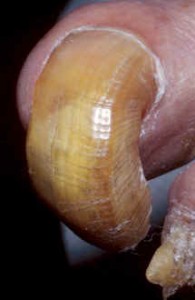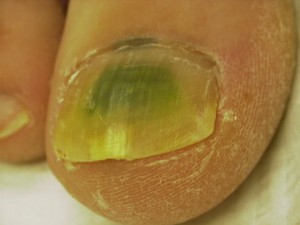Nail fungus, or Onychomycosis, occurs in almost 1 out of 10 Americans, yet few people understand what it is. To help you recognize nail fungus, we’ve listed the most common symptoms and side effects here.
The 5 most common effects of nail fungus:
1) Nail thickening

When the fungus spreads under the nail, it is common for the nail to appear thicker and more brittle. Even though some people wish their toenails looked thicker, this infection weakens the nails and the enlargement causes discomfort.
2) Brittleness
The fungus tends to weaken the nail, making it more brittle. This can cause it to look worse, since the nail tends to chip, crack, and disintegrate. In bad cases, the nail can even split at the edges. Most of the time, the nail should not disintegrate too quickly, as long as the toenails are being taken care of.
3) Discoloration

Due in part to the poor health of the nail, and the color of the fungus, nails can become discolored when they are afflicted by the fungus. This color is most commonly pale yellow, but can be reddish, brown, or slightly orange.
4) Painfulness
Because of the brittleness of the nail, the surrounding skin is likely to be irritated when the nail rubs against it. If left untreated, the fungus also causes the skin to become inflamed, which aggravates the problem.
5) Psychosocial
Sometimes the worst symptom of nail fungus is the social or psychological effect that it has. Especially if toenails are seen in public, or if the infection is on fingernails, people are easily embarrassed by the affliction. This is because of how the nail looks when it is infected, and the social stigma attached to infections.
These symptoms tend to get worse if the fungus is left untreated, but if it is treated right away, most of these symptoms tend not to be bad at all. When considering getting the fungus removed, consider this simple solution through laser technology.


